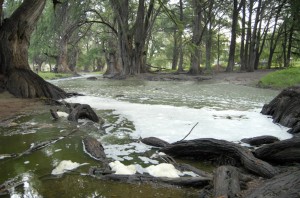 Mexico’s Jan. 24 federal register notice laying out the 200 pollutants that factories now must report annually opens the curtain for the sun to shine after a nearly 20-year-long grassroots crusade to secure the public’s right to know about hazardous waste.
Mexico’s Jan. 24 federal register notice laying out the 200 pollutants that factories now must report annually opens the curtain for the sun to shine after a nearly 20-year-long grassroots crusade to secure the public’s right to know about hazardous waste.
Environmental organizations in Mexico, the United States and Canada have been bucking for enforcement of mandatory disclosure of industrial toxic emissions ever since authorities of the three countries in the North American Free Trade Agreement (NAFTA) agreed in a 1995 resolution that this country’s practices and standards should be comparable to its northern neighbors.
However, dating back four presidential terms to the administration of Ernesto Zedillo, the Environment and Natural Resources Secretariat (Semarnat) has been promising to promulgate the rules — and breaking the promises.
Behind the federal flimflam has been a gaggle of backward-looking corporate henchmen. They don’t recognize the economic advantages their colleagues abroad enjoy as a result of the accountability requirements for facility-specific chemical discharges in other countries.
With the new list of 200 specific pollutants, at least some of the facts will be revealed about companies’ releases to air, water, and land of dozens of environmental bad-boys, ranging from arsenic and asbestos, to warfarin and xylene.
“What gets measured gets managed” is the motto of forward-looking executives, and plenty of environmental managers around the globe. Together they have demonstrated that the information they compile for mandatory reports to Pollutant Release and Transfer Registers (PRTRs) motivates improvements that generate bottom-line savings on inputs of chemicals, water and energy.
PRTR advocates in Mexico spent 2013 in negotiations with the feds and obstructionists to increase the proposed 200 substances to 330. The U.S. pollutant register covers 600 substances, while Canada’s applies to 336.
Championing the cause were representatives of the non-governmental organizations Fronteras Comunes, A.C.; Greenpeace México, A.C.; Centro de Análisis y Acción en Tóxicos y sus Alternativas (CAATA); Proyecto Fronterizo de Educación Ambiental, A.C.; Asociación Ecológica Santo Tomás, A.C.; Colectivo Ecologista A.C.; Asociación de Productores Ecologistas Tatexco, A.C.; Periodismo Para Elevar La Conciencia Ecológica; Amigos De La Tierra, A.C.; Eco Urbe Consultores, S.C., y Revuelta Verde.
The campaigners failed to add a single substance to the list approved and, in the end, were forced to concede that their main accomplishment was having kept the original 200 from the guillotine.
The additional substances, like the original 200, are among the worst in the manufacturing world. Some are bio accumulative; some can cause central nervous system disorders; some lead to terminal illness, such as cancer; and others produce endocrine disruption in humans – not to mention death to other animals and plants.
However, the president of the National Advisory Committee for Environment and Natural Resources Standardization, Cuauhtémoc Ochoa Fernandez, disqualified the proposed additions. The most common reasons he gave were lack of technical justification and inadequate scientific source referencing.
The good news is that the foundation for Mexico’s pollution register is finally resting on the firm ground of this set of standards, known as the Mexicana Official Standard (NOM) 165.
Business competitors now can look forward to a more level playing field, and community members can hope for enforcement of pollution controls leading to better health.
Standards for pollution registers around the world include an evolving list of substances, continually expanded based on demonstrated need.
With the lessons learned from this first round of codification, Mexico’s Pollutant Release and Transfer Register can be revised to become ever more comparable with trade partners, leading to improved environmental justice.
To date, the advocates of advancing the register have been working as volunteers or with measly crumbs of assistance. What’s needed to expand the register is strong financial and technical support from many sectors, both domestic and foreign.
Talli Nauman is a longtime Americas Program contributor and columnist, and founder and co-director of Journalism to Raise Environmental Awareness.
Photo: Greenpeace



